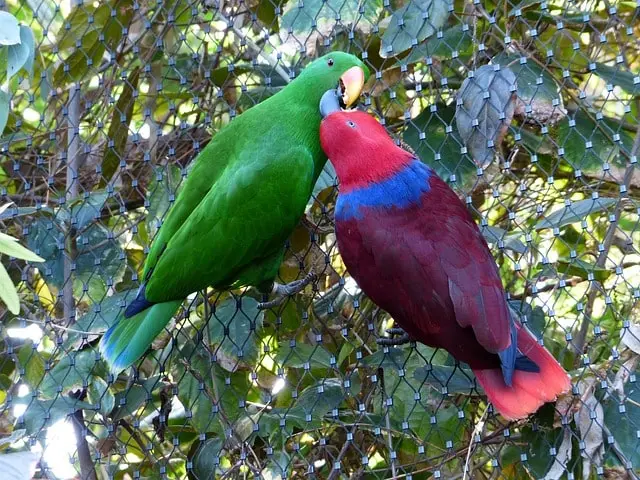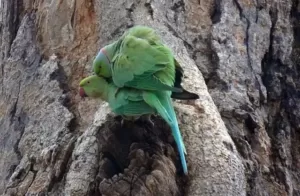The mating process in parrots is not as straightforward as it is in mammals. Parrots mate once or twice a year, typically as spring comes around. During the breeding season, parrots experience hormonal changes that activate their reproductive instincts.
When parrots receive these signals from the environment they begin their search for a mate. This involves intricate courtship rituals, where males make various physical as well as behavioral displays to attract a partner. Once the parrots have paired up, they stay together for at least one breeding season because they are socially monogamous creatures.
Since most parrots are secondary cavity nesters, they look for empty nest sites that may be right for raising their offspring. The final step is the act of mating itself. This involves a brief cloacal kiss, where the male transfers sperm to the female.
Quick Navigation
When Do Parrots Mate?
Parrots are seasonal breeders, which means they only enter their reproductive cycle during certain times of the year. The breeding season for most species of parrots is in the spring when the conditions for raising their offspring are conducive.
The breeding season is characterized by various environmental changes including an abundance of food, warmer temperatures, and more daylight hours, which tells parrots that the conditions for mating and raising chicks are favorable.
How Do Parrots Attract A Mate?
The vibrant plumage of parrots splashed with a spectrum of vivid colors is undeniably captivating for us. However, in the parrot kingdom, this is not enough for male parrots to get female’s attention.
Around 75 percent of parrot species are sexually monomorphic, which means parrots of the same species do not look very different from each other irrespective of their gender. This is why parrots adopt various tactics in addition to their feather colors to court their desired females.
Healthier And Brighter Plumage
Along with being colorful, a parrot’s plumage must look healthy and attractive. This is why parrots spend so much time preening their feather so they look their best. A parrot with healthy and brighter-looking feathers is considered to be the ideal mate and preferred by females.
Vocalizations
Male parrots use their loud calls to get the attention of females. They use their repertoire of vocal skills during the mating season and often increase their vocalizations. Many parrots have special mating calls that they use to stand out.
Mating Displays
Parrots engage in various physical displays to attract mates. This can involve dancing, puffing up their feathers, spreading their wings, and bobbing their heads. These often come later in the courting rituals when the female parrot starts showing interest.
Scent
Parrots, like many other animals, use smells to communicate. The uropygial gland which secretes oil that parrots use to apply to their feathers does not have sex pheromones.
However, they play a role in attracting mates for breeding. According to Nature Journal, male and female parrots have different body odors, which helps them distinguish their gender. This means that parrots have sexually dimorphic odors.
Courtship Feeding
Courtship feeding is the concluding stage of mate selection in parrots. It involves the parrots kissing and touching their beaks to regurgitate food into each other’s mouths. When the male and female parrots have paired up, they offer each other regurgitated food.
This gesture is also known as allofeeding and occurs when the bond between the two lovers has been established. However, this courtship ritual continues even during the incubation phase as the male brings food for the female who is sitting on the eggs.

Reproductive Organs In Male And Female Parrots
Like all reproducing species, parrots have reproductive organs. However, these organs are located internally. From the outside, we only see the cloaca, which is a single opening that serves as the exit for waste and the expelling of eggs and sperm.
Reproductive Organs In A Male Parrot
In male parrots, the reproductive system consists of the testes and the vas deferens. The testes is where the sperm is produced and the vas deferens is a long tube that connects the testes to the cloaca.
Reproductive Organs In A Female Parrot
The female reproductive system of a parrot is made up of two parts: the ovary and the oviduct. In most female parrots, the left ovary and oviduct are functional.
The ovaries produce the eggs in female parrots. When the ovum (egg cell) has matured, it travels to the oviduct where it is further developed.
How Do Parrots Have Sex?
Parrots, unlike mammals, do not have external sex organs. Male and female parrots have what is called a cloaca. It is a common opening for excretion, eggs (in females), and sperm (in males).
The act of mating in parrots involves the transfer of sperm from the male to the female. Below is a description of how mating takes place between two parrots:
Cloacal Kiss
During mating, the male parrot mounts the female’s back to perform the “cloacal kiss.” The female moves its tail while the male adjusts itself on her back so the two parrots can touch their cloacas together and sperm transfer can take place.

Sperm Transfer
The male transfers sperm to the female’s cloaca. This transfer is quick and usually occurs as a part of the mating ritual. Male parrots do not have penises, so they use the cloacal kiss method to inseminate the female.
Egg Fertilization
Once the sperm is transferred, it travels up the reproductive tract of the female to fertilize the egg. The fertilized egg then develops within the female parrot’s shell gland or uterus.
How Long Are Parrots Pregnant?
Parrots do not get pregnant in the same way mammals do. During the breeding season, the female goes in heat and starts ovulating. The female copulates with the male parrot who fertilizes the eggs.
The fertilized eggs are not ready to be laid yet as they are not properly formed. The egg develops in the oviduct for 24 to 48 hours on average depending on the size of the bird.
Do Male Parrots Sit On Eggs?
Both male and female parrots sit on the eggs after the clutch has been laid. They take turns sitting on the eggs though usually it is the female who sits on them longer. Male parrots are usually responsible for bringing food to the nest, which enables the female to take care of the nest and the eggs.
How Long Do Parrots Incubate Their Eggs?
The incubation period can vary depending on the parrot species. However, generally, parrots incubate their eggs for 2-4 weeks before they hatch. typically ranging from 18 to 30 days. Usually, smaller parrot species such as budgies have a shorter incubation period, while larger species like macaws require more time.
How Often Do Parrots Mate?
Most parrot species only mate once every year. Some species of parrots may mate two or sometimes three times a year. A parrot’s tendency to mate is influenced by factors such as environmental conditions, the availability of resources, and its species.
Can Parrots Lay Eggs Without Mating?
Female parrots can lay eggs without mating. It is possible through a process called parthenogenesis. Parthenogenesis is a form of reproduction where an egg develops into an embryo without being fertilized by sperm.
However, this typically occurs in captive parrots when they go into heat. It is very rare in the wild for a female parrot to lay an unfertilized egg. In the wild, female parrots begin laying eggs only after they have found a suitable partner and made all the arrangements to raise the chicks.
References and further readings:







